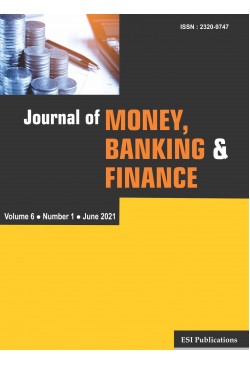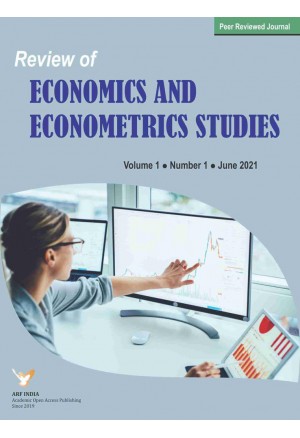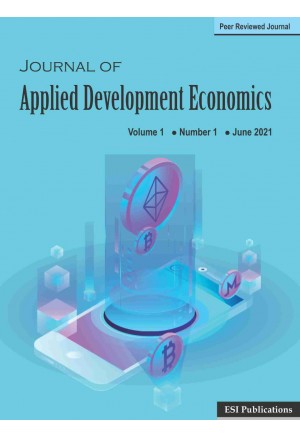JMBFJournal of Money, Banking and Finance

Peer Reviewed Journal
Find out more
Latest Articles :- Vol: (8) (2) (2023)
Monetary Policy and Macroeconomic Volatility in Nigeria
BY: Marshal Iwedi
Journal of Money, Banking and Finance, 2023, Vol: (8), Issue: (2), PP.119-139
Received: 20 June 2023, Revised: 14 July 2023, Accepted: 20 July 2023, Publication: 28 December 2023,
Macrconomic volatility encompasses a range of indicators including high inflation, elevated unemployment rates, diminished GDP growth, and fluctuations in currency stability. It is intimately tied to the cyclical nature of business, marked by periods of growth and contraction. Central banks wield monetary policy as a tool to temper these fluctuations, utilizing adjustments in interest rates and money supply to stimulate or restrain economic activity. This study delves into the intricate relationship between monetary policy and macroeconomic volatility in Nigeria. It investigates the impact of monetary instruments, including money supply, interest rates, and exchange rates, on key economic indicators such as inflation and economic growth. The research employs a quasi-experimental approach, combining theoretical insights with empirical observations spanning from 1985 to 2021. Through rigorous econometric analysis, including multiple linear regression, the study discerns the causal links and quantifies the significance of these monetary policy variables on Nigeria’s economic stability. The findings offer valuable insights for policymakers seeking to mitigate economic volatility and promote sustainable growth.
Keywords: Monetary Policy, Macroeconomic Volatility, Nigeria, Inflation, Economic Growth, Money Supply, Interest Rates, Exchange Rates, Quasi-Experimental Approach, Econometric Analysis.
Marshal Iwedi (2023). Monetary Policy and Macroeconomic Volatility in Nigeria. Journal of Money, Banking and Finance, 8: 2, pp. 119-139.
Effect of Commercial Banks’ Loans and Advances to Agricultural Sector on Agricultural Value Added Growth Rate in Nigeria
BY: Zwingina, Christy Twaliwi, U. C. Anochie and Chukwu, Peter Damain Ezechi
Journal of Money, Banking and Finance, 2023, Vol: (8), Issue: (2), PP.141-157
Received: 22 July 2023, Revised: 08 August 2023, Accepted: 19 August 2023, Publication: 28 December 2023,
This study was carried out to evaluate the effect of commercial banks’ loans and advances on agricultural sector on agricultural value added growth rate in Nigeria between 2003 and 2022 using annual time series data sourced from Central Bank of Nigeria Statistical Bulletin and World Bank Development. Agricultural value added growth rate was used as the dependent variable while commercial banks’ loans and advances to agriculture was used as the independent variable. Auto Regressive Distributed Lag (ARDL) Model was used to analyze data. The results of ARDL Model revealed that commercial banks’ loans and advances to agricultural sector had a significant positive relationship with agricultural value added growth rate in Nigeria. The researchers’ therefore recommended that Commercial banks should encourage agricultural sector value added growth by granting loans and advances when needed to intending entrepreneurs to venture in agriculture value added activities, among others.
Keywords: commercial banks’ loans and advances, agricultural value added, agricultural financing, agricultural sector, Auto regressive distributed lag model.
Zwingina, Christy Twaliwi, U.C. Anochie & Chukwu, Peter Damain Ezechi (2023). Effect of Commercial Banks’ Loans and Advances to Agricultural Sector on Agricultural Value Added Growth Rate in Nigeria. Journal of Money, Banking and Finance, 8: 2, pp. 141-157.
Government Expenditure on Agricultural Sector and Agricultural Value Added Growth Rate in Nigeria
BY: Agbaeze, Clifford Chilasa, E. A. Adegun and Umoh, Emmanuel Alphonsus
Journal of Money, Banking and Finance, 2023, Vol: (8), Issue: (2), PP.159-177
Received: 12 August 2023, Revised: 10 September 2023, Accepted: 19 September 2023, Publication: 28 December 2023,
This study was carried out to evaluate the impact of government expenditure on agricultural sector on agricultural value added growth rate in Nigeria between 2003 and 2022 using annual time series data sourced from Central Bank of Nigeria Statistical Bulletin and World Bank Development. Agricultural value added growth rate was used as the dependent variable while government expenditure on agriculture was used as the independent variable. Auto Regressive Distributed Lag (ARDL) Model was used to analyze data. The results of ARDL Model revealed that government expenditure on agricultural sector had a significant negative relationship with agricultural value added growth rate in Nigeria. The researchers’ therefore recommended that government should fund or support intending agricultural investors and producers through financial initiatives that would help in developing value added enterprises/businesses.
Keywords: government expenditure, agricultural value added, agricultural financing, agricultural sector, Auto regressive distributed lag model.
Agbaeze, Clifford Chilasa, E.A. Adegun & Umoh, Emmanuel Alphonsus (2023). Government Expenditure on Agricultural Sector and Agricultural Value Added Growth Rate in Nigeria. Journal of Money, Banking and Finance, 8: 2, pp. 159-177.
Agricultural Credit Guarantee Scheme Fund and Agricultural Value Added Growth Rate in Nigeria
BY: Chukwu, Peter Damain Ezechi, Onoh, Uloma Adonye and Umoh, Unyime Emmanuel
Journal of Money, Banking and Finance, 2023, Vol: (8), Issue: (2), PP.179-195
Received: 12 September 2023, Revised: 26 October 2023, Accepted: 30 October 2023, Publication: 28 December 2023,
This study was carried out to evaluate the impact of agricultural credit guarantee scheme fund on agricultural sector on agricultural value added growth rate in Nigeria between 2003 and 2022 using annual time series data sourced from Central Bank of Nigeria Statistical Bulletin and World Bank Development. Agricultural value added growth rate was used as the dependent variable while agricultural credit guarantee scheme fund on agriculture was used as the independent variable. Auto Regressive Distributed Lag (ARDL) Model was used to analyze data. The results of ARDL Model revealed that agricultural credit guarantee scheme fund on agricultural sector had a non-significant negative relationship with agricultural value added growth rate in Nigeria. The researchers’ therefore recommended that there should be increase in the amount of funds which the agricultural credit guarantee scheme injects into agricultural sector on annual basis so as to enhance agricultural value added growth in Nigeria, Since value added involves marketing/exchanges where buyers and sellers must benefit, agriculture value added should be improved in providing product at a desired place, assortment and at a desired time since value-added products are customer-oriented than producer-oriented.
Keywords: agricultural credit guarantee scheme fund, agricultural value added, agricultural financing, agricultural sector, Auto regressive distributed lag model
Chukwu, Peter Damain Ezechi, Onoh, Uloma Adonye & Umoh, Unyime Emmanuel (2023). Agricultural Credit Guarantee Scheme Fund and Agriulcutral Value Added Growth Rate in Nigeria. Journal of Money, Banking and Finance, 8: 2, pp. 179-195.
Digital Finance Transactions and the Stability of Nigeria Financial Markets
BY: Henry Waleru Akani and I. Rogers-Banigo
Journal of Money, Banking and Finance, 2023, Vol: (8), Issue: (2), PP.197-226
Received: 22 September 2023, Revised: 30 October 2023, Accepted: 02 November 2023, Publication: 28 December 2023,
This study examined the effects of digital finance on the stability of Nigeria financial markets. The objective was to examined how digital finance affects stability of Nigeria financial markets. Time series data were sourced from Central Bank of Nigeria Statistical Bulletin. Percentage of broad money supply and percentage of private sector credit was used as dependent variables while automated teller machine, point of sales, mobile payment and electronic fund transfer. Ordinary least square was used as data analysis methods. the study found that 46.5 percent variation in the dependent variable was explained by the independent variable, the model was found to be statistically significant while the Durbin Watson found that the absence of serial autocorrelation among the variables in the time series. Beta coefficient of the variables shows that ATM has negative effect on the dependent variable while POS, MP and EFT have positive and significant effect on financial sector stability. 50 percent variation in the dependent variable was explained by the independent variable, the model was found to be statistically significant while the Durbin Watson found that the presence of serial autocorrelation among the variables in the time series. Beta coefficient of the variables shows that ATM has negative effect on the dependent variable while POS, MP and EFT have positive and significant effect on financial sector stability. From the findings, the stud conclude that digital fiancé have significant effect on financial market stability. It recommends that policies such as the cashless policy and the e-naira should be integrated with the objective of achieving financial markets stability in Nigeria.
Henry Waleru Akani & I. Rogers-Banigo (2023). Digital Finance Transactions and the Stability of Nigeria Financial Markets. Journal of Money, Banking and Finance, 8: 2, pp. 197-226.
Persistence in the Cryptocurrency Market: The Impact of the Covid-19 Pandemic and of the Russia-Ukraine War
BY: Guglielmo Maria Caporale, Amir Imeri and Luis A. Gil-Alana
Journal of Money, Banking and Finance, 2023, Vol: (8), Issue: (2), PP.227-235
Received: 02 October 2023, Revised: 05 November 2023, Accepted: 12 November 2023, Publication: 28 December 2023,
This paper uses fractional integration methods to analyse persistence in the five cryptocurrencies with the highest degree of market capitalization (Bitcoin, Ethereum, Tether, BNB and USD Coin), and also the possible impact of both the Covid-19 pandemic and the Russia-Ukraine war. The findings suggest mean reversion in the case of the USD Coin, an explosive pattern in the case of BNB, and anti-persistence in the case of Tether. The unit root null hypothesis cannot be rejected in the case of Bitcoin, Ethereum and USD Coin, whilst it is rejected in favour of d > 1 in the case of BNB (where d is the fractional differencing parameter measuring persistence). Finally, there is not much evidence that either the Covid-19 pandemic or the Russia-Ukraine conflict have significantly affected persistence in the cryptocurrency market.
Keywords: cryptocurrency; persistence; long memory; fractional integration
JEL Classification: C22, G12
Guglielmo Maria Caporale, Amir Imeri & Luis A. Gil-Alana (2023). Persistence in the Cryptocurrency Market: The Impact of the Covid-19 Pandemic and of the Russia-Ukraine War. Journal of Money, Banking and Finance, 8: 2, pp. 227-235.
Hierarchical Component Model Approach on Tax Fairness, Public Governance Quality and Tax Compliance: A Mediating Role of Tax Morale
BY: Bello, Umar, Dandago, Kabiru Isa and SAMAILA, Ishaq Alhaji
Journal of Money, Banking and Finance, 2023, Vol: (8), Issue: (2), PP.237-257
Received: 29 October 2023, Revised: 25 November 2023, Accepted: 08 December 2023, Publication: 28 December 2023,
This study assesses the effect of public tax fairness, public governance quality on tax compliance of MSEs in North-East of Nigeria through tax morale. The study population comprises of the entire 124,231 registered MSEs operating in the North-Eastern states of Nigeria. A sample size of 527 was arrived at after considering non response rate. PLS-SEM was employed to ensure data analysis and hypotheses testing. Internal consistency reliability and validity checks were carried out to ensure that the measurement instrument (Questionnaire) is reliable and valid for data collection. The result of the checks reveals that the instrument is reliable and valid for the study. The findings revealed that direct assessment tax compliance is found to have been positively influenced by public governance quality and tax morale. While, tax compliance was not significantly explained by tax fairness tax morale mediated the effect of public governance quality on tax compliance while no mediation was experience on tax system fairness and DAT compliance. Therefore, the study recommends that government to improve on the quality of its governance by controlling corruption, ensuring rule of law, guarantee political stability and improve on accountability since positive improvement on this factors improves tax morale which consequently improves tax compliance.
Keyword: Public Governance Quality, Tax Fairness, Tax Morale, Tax Compliance
Bello, Umar, Dandago, Kabiru Isa & Samaila, Ishaq Alhaji (2023). Hierarchical Component Model Approach on Tax Fairness, Public Governance Quality and Tax Compliance: A Mediating Role of Tax Morale. Journal of Money, Banking and Finance, 8: 2, pp. 237-257.
Copyright ©2023 ESI Publications. All Rights Reserved


-300x438.jpg)

